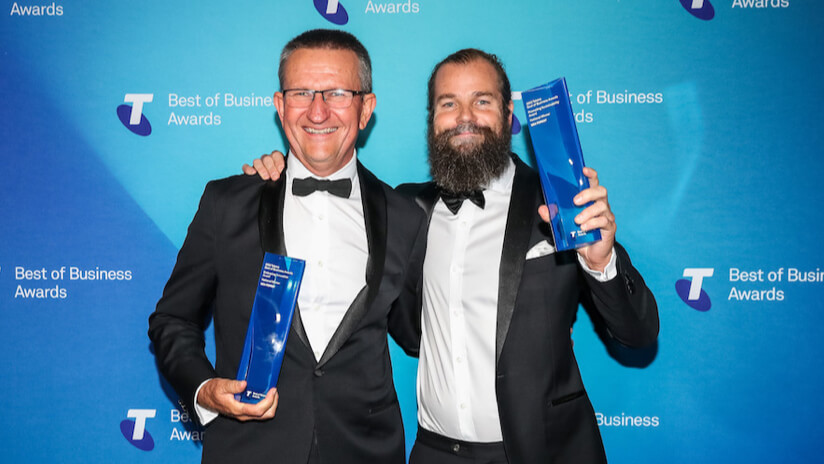Ways to use tech to solve challenges

How technology is helping the small business boom
In its recent report 'Where opportunity lies: Australia’s new small business boom', Xero revealed that Australia has seen a surge in small business creation as we continue to adapt to uncertainty and wish for greater stability in years to come. At the heart of this boom is innovation and technology.
Indeed, according to Joseph Lyons, Managing Director, Xero Australia & Asia, ‘the rapid acceleration in adopting technology helped new business entrants survive, and even thrive, through disruption and bumps in the road to pandemic recovery.’
Australian businesses leading the way with tech innovation
Sea Forest, Digitally Buzzed and CIM have all been recognised for their ability to innovate, pivot, and scale with technology. And while these businesses adopt different approaches, they are all helping to increase tech accessibility in Australia.
Its visionary leadership saw Tasmania based Sea Forest crowned as the national winner of the Embracing Innovation category at the Telstra Best of Business Awards in 2022. With Northern Territory based Digitally Buzzed, and New South Wales based CIM announced as state winners in the same awards category.
All three businesses agree that their success lies in their ability to adapt to technology trends. Keep reading to learn how each brand is taking steps to build a brighter future.
Sea Forest, Tasmania

Image: Sea Forest chief scientist Dr Rocky de Nys (Left), and Co-founder and CEO Sam Elsom (Right) at the Telstra Best of Business Awards.
Sea Forest is an eco-tech company that grow Asparagopsis, a common red seaweed native to Tasmania. Small amounts of the seaweed are used as a livestock feed supplement, which greatly reduces methane emissions.
By combining tech and science, they’ve pioneered new ways to cultivate and harvest seaweed, which is grown in marine and land tanks, alongside a hatchery. They’ve also accelerated the Asparagopsis reproduction rate and improved the plant’s suitability for livestock feed systems. This combination of science and tech inform every decision Sea Forest makes.
Since co-founder and CEO Sam Elsom launched the business in 2018, Sea Forest has continued to set ambitious targets. Its vision is simple: create solutions that help fight climate change and generate more food with fewer resources. The company’s aim is to contribute to approximately 0.43% of Australia’s 2030 Emission Reduction Target.
Business goals and achievements
- Became the first company in the world to commercially grow Asparagopsis.
- Partnered with leading research teams across Australia and New Zealand to optimise the production of seaweed.
- Developed multiple innovative solutions to support seaweed farming and processing and its suitability as a livestock feed additive.
- Are dedicated to fighting climate change by setting their own ambitious targets.
Under the guidance of chief scientist Dr Rocky de Nys, Sea Forest invests heavily in research and development. Collaborations with the University of Tasmania, James Cook University and Waikato University have allowed the team to fast-track the commercialisation of their SeaFeedTM supplement.
Since 2020, Sea Forest have successfully supplied their SeaFeedTM supplement to multiple university trials and beef and dairy customers, including Fonterra and the Australian Agricultural Company (AACo). They’ve also teamed up with menswear brand MJ Bale on world-first production of carbon-neutral wool – achieved by feeding a Tasmanian flock of sheep the seaweed supplement.
Sea Forest are now at an exciting stage of commercialisation, which sees them working closely with several local and international customers.
Sea Forest embodies visionary leadership. Their passion for tackling climate change within Australia’s agricultural industry has pushed them to develop creative solutions. It touches every facet of their business, from their supply chain and marketing to their operations and production.
Our diverse team is making the most remarkable progress in pioneering the development of a new industry for Australia in seaweed aquiculture. At the same time, we’re also helping to de-carbonise our agricultural sector.
- Sam Elsom, co-founder and CEO of Sea Forest
Digitally Buzzed, Northern Territory

Image: Founder and director of Digitally Buzzed, Bel Cook, holding her 2022 Telstra Best of Business Award.
Digitally Buzzed is a digital agency paving the way for tech in the Northern Territory. The team of highly skilled software developers, app developers, digital producers and digital designers are always thinking of new ways to innovate. Founder and director Bel Cook launched the business in 2017, but it soon expanded and now develops virtual reality, augmented reality, and bespoke drone show software.
Digitally Buzzed like to bring a sense of play to their work. “I wanted to make new and rarely seen before technology,” Bel explains. “That inspired me to create drone show software.” A new concept for many Australians, the software programs up to 500 drones at a time to form breathtaking LED light shapes and patterns.
The group are behind some of the Northern Territory’s most show-stopping tech experiences. In 2020, Digitally Buzzed created an augmented reality app for the Darwin Street Art festival on behalf of the Northern Territory Government. The app turns street art murals into interactive experiences that allow participants to watch the artwork come to life on their screens, a COVID-safe activity that has helped to increase attendance at community events in recent uncertain times.
Business goals and achievements
- Develop bespoke digital solutions to help businesses streamline their workflow and processes.
- Build mobile apps that elevate engagement with events like the Darwin Street Art Festival and the Darwin Laksa Festival.
- Create innovative technology experiences with Augmented Reality and drone light show software.
The Digitally Buzzed team loves working with local Northern Territory businesses. They also developed an interactive app for the Darwin Laksa festival. The app encouraged participants to try dishes at different restaurants and vote for their favourite. During the festival’s 4-week period, it boosted the local economy by 15%, providing much-needed support for small hospitality businesses.
During lockdowns they branched into new territory– helping bricks and mortar stores move online and hospitality businesses offer online ordering and delivery.
In more recent times, Bel has released new business offerings based on what she learnt throughout the last few years.
“I realised that making some custom solutions can take too long for us and for the client. A lengthy project can affect my cashflow. As a result, I created three off the shelf apps that clients can purchase and update content themselves in real-time.”
My goal is to bring the Territory up with the times and generate jobs in the digital area.
- Bel Cook, founder and director of Digitally Buzzed
CIM, New South Wales

Image: CIM’s VP of Operations Janine Lee (Left), and Head of Engineering Antonious Mickael (Right).
CIM is a data analytics software provider that analyses buildings. Large buildings are complex and costly to manage and CIM helps building owners and stakeholders make better use of what they have on-hand to save money and reduce energy consumption. The company developed the PEAK Platform, a software that helps to interpret data and suggest solutions for optimum efficiency.
“When Australia’s major airports, shopping centres and commercial offices started closing in 2020, many building managers and owners realised that data was the only life raft for their businesses to survive,” says David Walsh, founder and CEO of CIM. It was a move that saw the company onboard 48 new buildings on the PEAK platform in seven weeks.
The platform integrates building analytics, artificial intelligence and technical engineering support and provides solutions to improve sustainability, efficiency and comfort.
Business goals and achievements
- Shifted perspectives on the use of data analytics to monitor large buildings and its importance, driving operational efficiency, superior financial performance, and environmental impact.
- Developed the PEAK Platform: a building analytics tool that integrates building intelligence, machine learning and technical engineering support to improve efficiency, sustainability and comfort across sites and property portfolios.
- Supported an industry wide pivot during COVID-19 to help building managers monitor and optimise their buildings whether working on-site or remotely.
A recent addition to the platform is PEAK Actions. “PEAK Actions brings together site teams, contractors and analysts to raise tasks, track progress and maintain a complete digital history of the building,” says David. “It helps reduce wastage and ultimately improves the economic and environmental performance of the building.”
By tapping into their client’s needs, CIM have helped to create long-term benefits for building managers and their tenants.
In a year where COVID-19 shone the spotlight on the necessity to do more with what we already have in the built environment, the PEAK Platform shone through as a pioneering world-first technology solution.
- David Walsh, founder and CEO of CIM
Ways your business can help make a difference
Sea Forest, Digitally Buzzed and CIM show that there is no one-size-fits-all approach to innovation. It’s about thinking differently and finding new ways to solve problems – whether that’s reducing livestock methane emissions, improving tech accessibility, or encouraging a new level of building efficiency.
Want support to develop an idea?
If you’ve got an idea you’d like to develop, you may be eligible for a grant or other support. To learn more about available funding, grants and programs in Australia, visit How to find and apply for small business grants.
If you’d like to learn how technology solutions can support your business, the Business Tech Toolkit is a great place to start.
This article does not necessarily reflect the views of Telstra or its staff.
Get involved in our Telstra Best of Business Awards
The Awards give small to medium-sized businesses a platform to celebrate their achievements and stories with peers. Plus, opportunities to learn from Australia's best business minds. Nominate your own or another remarkable business today.
Empower yourself to get the most from technology
Learn how to choose the right technology solutions. Get help to boost efficiency, build skills, and integrate tech.




